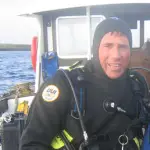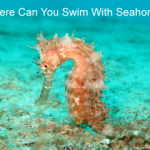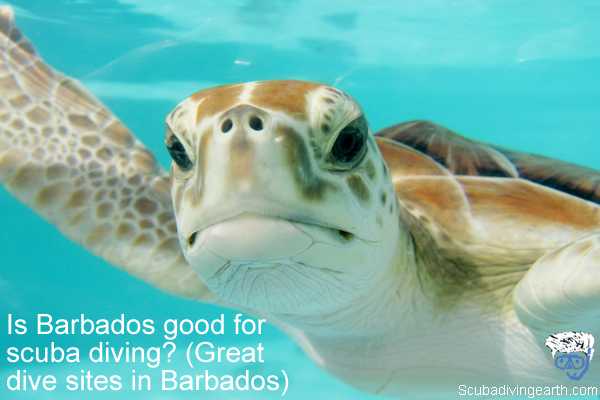
Scuba diving Barbados; where to dive and what it’s like
If you’re considering scuba diving Barbados and not been before, let’s take a look at the diving and the dive sites. Barbados will always have a place in my heart as my wife and I got married on a Barbados beach, and we try to go back every year.
Is Barbados good for scuba diving? Barbados is great for scuba diving and offers year-round diving for beginners to advanced divers. Barbados diving highlights include shark diving at the top of the Island through to an abundance of seahorses and turtles on the west coast. If you like wrecks there’s a choice of shallow and deeper wrecks to enjoy too.
I’m here at the Tamarind Hotel in Payne’s Bay, Barbados and looking forward to doing two dives tomorrow, Brightledge Reef and the Pamir wreck. So I thought I’d write an article on whether scuba diving is good in Barbados.
The best way to dive the Caribbean, and not necessarily Barbados, is by a scuba diving liveaboard. You can check the latest and best deals on Caribbean liveaboards using the following window:
7 top dive sites in Barbados to dive
The following dive sites are recommended diving:
- Sharks Hole – A drift dive to 18-30 metres (60-96 feet) for advanced divers – Highlight “Nurse Sharks”.
- Cement Works (or Cement Plant) – Shallow dive to 6-10 metres (20-33 feet) for all certification levels – Highlight “Seahorses”.
- Brightledge Reef – A gentle drift dive to 17-40 metres (55-132 feet) for all certification levels – Highlight “Turtles”.
- Pamir Wreck – Wreck dive to 9-15 metres (30-50 feet) for all certification levels – Highlight “Easy wreck dive”.
- S.S. Stavronika Wreck – Wreck dive to 18-41 metres (60-135 feet) for advanced divers – Highlight “Largest wreck on Barbados”.
- Maycocks Reef – Drift dive to 15-40 metre (50-130 feet) for all skill levels – Highlight “Beautiful corals and sponges”.
- Barracuda Junction – Drift dive to 20-80 metres (65-80 feet) for intermediate certification level. Highlights “Barracuda”.
If you want to read a bit more about each of the above dive sites, read on, or jump to the section where these are explained in a bit more detail.
More Reading: Where Can You Swim With Seahorses (Best Place To Scuba Dive With Seahorses)
What is Barbados known for?
Flying fish is one of the national symbols of the island of Barbados. When you’re out on the water, be it sailing or on your way to a dive site, you’ll often see flying fish leap out of the water around you.
It is therefore no surprise that Barbados is known as ‘the land of the flying fish‘. Most restaurants will have flying fish on their menu and it is the country’s national dish.
Barbados is the most eastern lying of all Caribbean islands. It is an independent British Commonwealth nation where Bridgetown is the capital. Barbados is a great place to holiday and a lovely place to scuba dive.
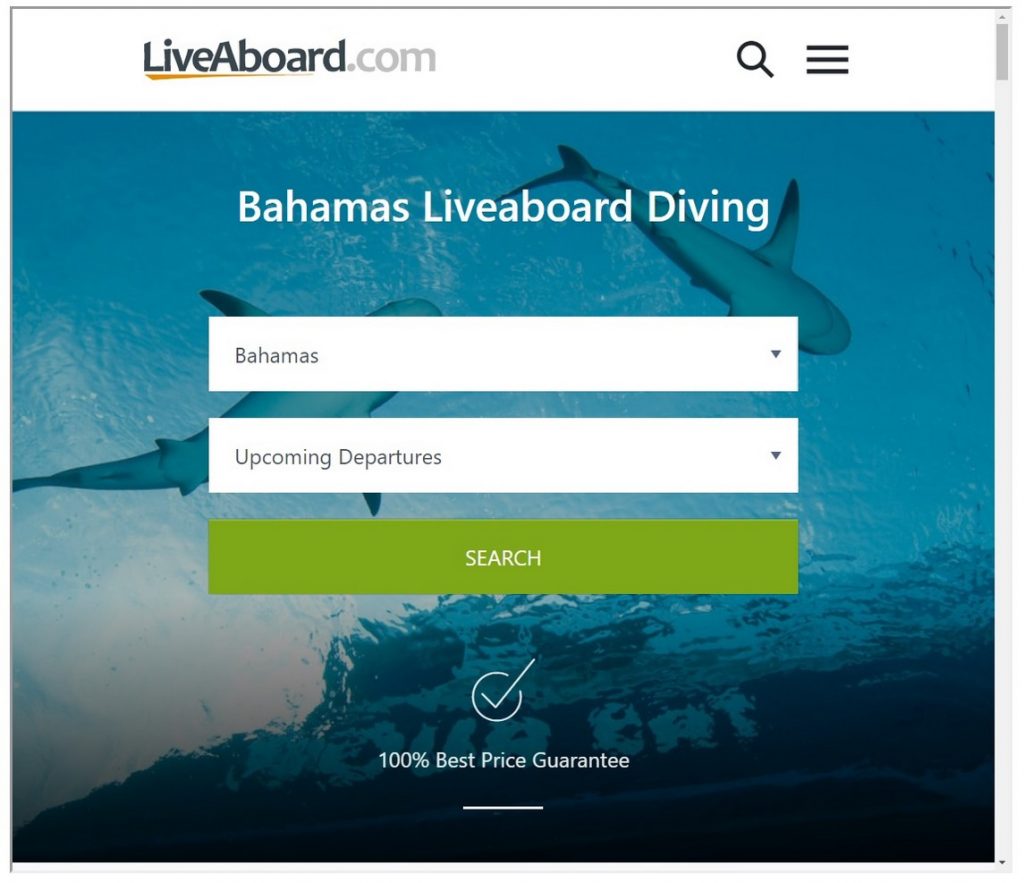
Is it safe to travel in Barbados?
Barbados is generally a safe place to travel and is considered a family-friendly destination. The people are friendly, the food is awesome and if you like rum, then it’s a must-go travel destination to visit.
But what about the diving and is Barbados good for scuba diving? Let’s take a closer look at the above listed seven dive sites.
Is Barbados good for scuba diving and where can you dive in Barbados?
Top 7 dives sites of Barbados in more detail:
1. Sharks Hole dive site Barbados
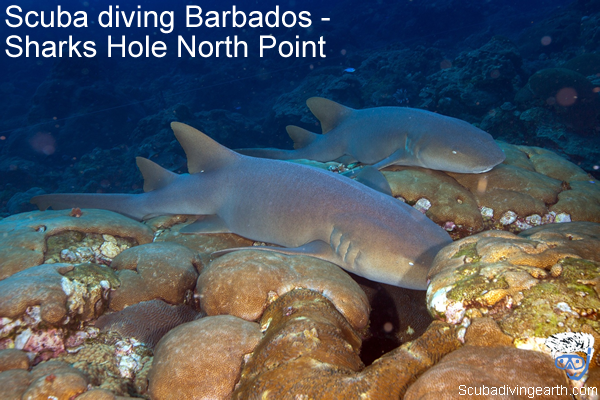
Sharks Hole is the most northern dive site on the Island of Barbados. It’s where the rougher western Atlantic Ocean meets the calmer eastern Atlantic. Often times the seas are choppy at the north point, which is mostly from the east of the island.
This makes diving Sharks Hole difficult and a challenge to plan in advance. It’s one of those dive sites that might crop up at the last minute, so if you want to dive it, be prepared to go or you may miss it!
However, if you want to dive Sharks Hole, you are probably better to visit Barbados between June and September when the Atlantic isn’t so rough. However, you are then into the hurricane season.
The Sharks Hole dive site is located off the coast near where the “Animal Flower Caves” which are on the tip of the north coast, and in themselves are worth a visit when you stay on the island.
You can only dive Sharks Hole when the water is flat, and when it is, you’ve got to get there quickly! You are probably better off using one of the northern dive companies “Reef and Wreckers“, which is run by the very friendly Philip. That way you’re closer to begin with.
The rugged coastal walls and caves at North Point continue underwater (see video below). In one of the areas of this dive site you’ll be able to dive through a passage or underwater tunnel/hole. It is this location where there’s a 90% chance of seeing resting nurse sharks.
To dive Sharks Hole you need to be an advanced diver and certified to dive to 30 metres (98 feet), which is the deepest point where the shark ‘holes‘ are located.
More Reading: How deep can you dive with an open water certification?
Scuba diving Shark Hole Barbados video
This great footage shows the caves and swim-throughs on the Shark Hole dive with Reefs and Wreckers and Phil.
THIS DIVE WAS REALLY AMAZING!!!!
2. Cement Plant or Works Barbados dive site
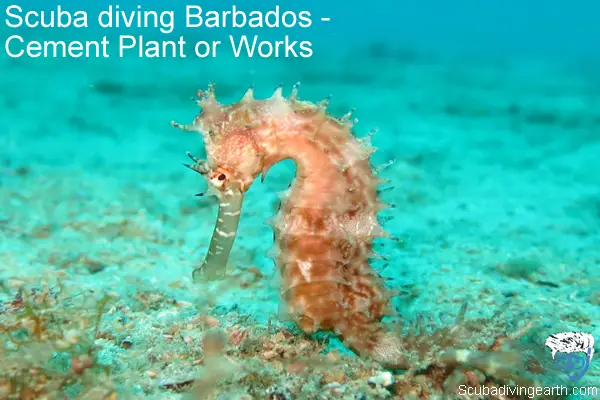
The Cement Plant or Works is not the prettiest of sites from above the water, but this is not an indication of what lies beneath the surface. This great little dive site makes a great shallow second dive.
But don’t be fooled when I say ‘second‘ dive site, as I’d happily dive first and second dives here. On one occasion I counter over 30 seahorse!
The Cement Works in Barbados is at a depth of between 6-10 metres (20-33 feet). It’s an easy dive and one that beginners scuba divers can enjoy too.
More Reading: The best liveaboard diving for beginners (10 top liveaboard destinations)
It’s like an octopuses garden, where the sea-life is vibrant and abundant.
The Cement Works is on the edge of the northwest coast of Barbados. The dive site consists of large steel pillars that go down into the sand.
These pillars or piles have created a safe haven for fish and other sea creatures to live. But for me the highlight of this great dive site is the seahorses you’re almost guaranteed to spot there.
But the other noticeable thing to see is the abundance of lobsters. I don’ think I’ve seen that many lobsters in once place before (see video below at around 1 minute 20 seconds). You’ll also see moray eels, turtles, flat fish, and a plethora of coral reef fish.
Cement Plant or Works video
Lionfish, Seahorse, Lobster, Filefish, Trumpet Fish, French Grunt, Turtle, Iain…
3. Brightledge Reef dive Barbados
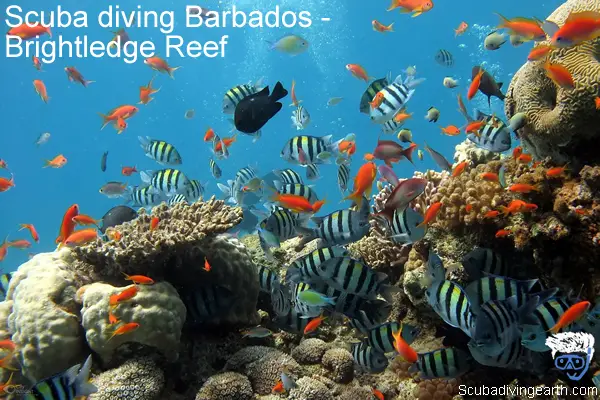
The Brightledge Reef dive site is a very popular dive site for those staying on the best side of Barbados, which is known as the “Platinum West Coast.”
You can pick your dive depth from 17 metres (55 feet) if you’re a beginner diver, to over (132 feet) if you’re more advanced or an experienced diver.
More Reading: What are common depths for experienced scuba divers (Scuba depths)
Brightledge reef is probably one of the most alive reefs there is on the island. It’s abundant with sea life, colour and excitement.
You’ll see Yellowtail Snapper, Horseye Jack, Trumpetfish, Lionfish, Spotted Filefish and schools of Barracuda. Not to mention the chance to see turtles, moray eels and octopus.
More Reading: Where’s the best tech dive liveaboard destinations in the world?
4. Pamir Wreck dive site Barbados
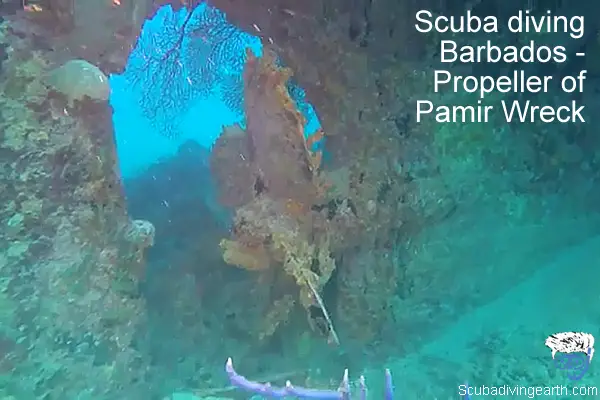
The Pamir wreck makes a great second dive as it’s in shallow waters just off from Speightstown.
The Pamir wreck is a 52 metre (170 feet) freighter that was sunk in 1985 especially for the purpose of scuba diving. If you’ve never dived on a wreck before, the Pamir is a great first time wreck dive.
“MS Pamir was scuttled as an artificial reef on the NW coast of Barbados.”
Pamir wreck – Wrecksite wrecks
One cool part to the Pamir is there’s an air pocket inside the wreck. This was once large enough for more than one diver at a time, but is now quite small. But there’s still a large enough air pocket for one diver to surface inside the wreck at a time.
But even if you’re a seasoned diver, this dive is still enjoyable. For example this year (i.e. 2019) on my visit to Barbados I saw a spotted eagle ray on the wreck.
But not only that, we lay on the sandy bottom to the side of the wreck to watch this beautiful spotted eagle ray feed for molluscs in the sand.
Filmed this young spotted eagle ray feeding in the sand
The Pamir is at a depth of between 9-15 metres (30-50 feet). The hull of the wreck has many large holes for easy entry and exit points to explore the wreck. She is covered with encrusting sponges and corals of various colours and types.
On the sand there’s also a family of garden eels too, which are great little creatures.
But also you can enjoy a night dive on this wreck due to it’s close proximity to the coast and its shallow depth.
More Reading: What Is Night Diving (21 Night Diving Tips)
Pamir Wreck video
5. S.S. Stavronikita Wreck Barbados
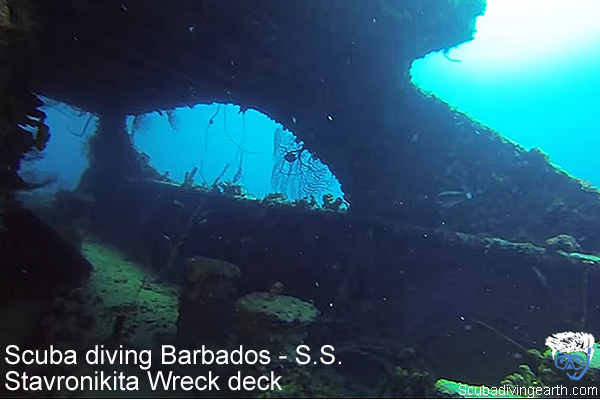
The largest wreck dive in Barbados, the S.S. Stavronikita, sits in 41 metres (135 feet) of water to the sea bed. The tip of one of its masts is at around 5-6 metres (16-20 feet) below the surface, which is a great place to do a safety stop.
More Reading: Emergency Decompression Stop vs Safety Stop (What’s The Difference?)
The S.S. Stavronikita is 111 metres (365 feet) in length and she sits perfectly upright on the sea bed.
This is a great wreck for wreck penetration, as there are large deck entry points to explore inside the wreck safely. So make sure to bring your dive torch so you’ll be able to see inside the wreck clearly.
The S. S. Stavronikita details:
“The SS Stavronikita was a valuble freighter that carried cement from Ireland to Barbados. On her last Voyage in August of 1976 the Stavronikita MV caught fire and went adrift. The fire rendered her useless and she stayed in port for 2 years.Then in 1978 the government of Barbados purchased her for $30,000. She was deliberately sunk 400 yards from shore to create an artificial reef rather than turn her into scrap metal.”
SS Stavronikita – Wrecksite wrecks.
In addition to being a great deep wreck dive where you’ll either max out at 36 metres (118 feet) by exploring the bow holds, or 40 metres (131 feet) if you want to dive down to see the propeller, it’s also host to an abundance of sea life.
More Reading: What Is Deep Diving For Scuba Divers? (26 Tips For Deep Scuba Diving)
You’ll see chromis, creole wrasse, jacks, sergeant majors, lobster and the occasional hawksbill or green sea turtle if you’re lucky.
It is difficult to do the dive on the S.S. Stavronikita without going into short decompression stop. But this decompression stop time can be done on your way back to the mast, before your final ascent.
More Reading: How Deep Can You Dive Without Decompression (No Decompression Stop Limits)
S.S. Stavronikita Wreck video
SCUBADELPHIA in Barbados on the S.S.Stavronikita.
6. Dive site Maycocks Reef Barbados
Maycocks Reef is a great dive site for both novice divers and experienced divers alike. This is a drift dive, so is done with a Diver Below Float or surface marker buoy.
The Maycocks reef is on the West of Barbados and runs East to West. Between the reefs are sandy channels, which makes it look a bit light a jigsaw puzzle. This reef is too large to cover in a single dive, so is worth doing more than once.
You’ll see Plate Star Coral, Brain Coral and Orange Elephant Ear Sponge, with Sea Plumes, Sea Fans, Gorgonias, Yellow Tube and Purple Finger Sponges in abundance on Maycocks.
You’ll see plenty of Blue Headed Wrasse and Creole Wrasse, plus many other coral reef fish. These include Hogfish, Brown Chromis, Squirrelfish and Hamlets. But then you may also see rays and turtles too.
7. Barbados Barracuda Junction dive site
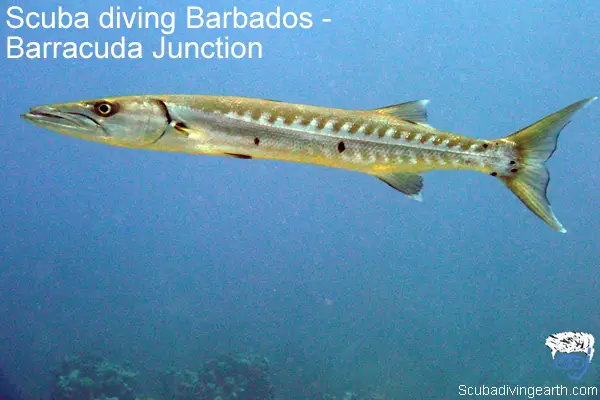
Barracuda Junction reef lives up to it’s name, so you can expect to see schools of barracudas swimming around the reef.
This reef includes loads of colourful corals and unusually-shaped sponges. These in turn bring a wide range of coral reef fish species along with the predators looking for easy prey.
Dive companies on Barbados Island
There are a number of dive companies and ways to scuba dive Barbados. These include the following companies:
- Reef and Wreckers – Douglas; Website.
- Eco Dive – Bridgetown; Website.
- The Dive Shop – Bridgetown; Website.
- Barbados Blue Water Sports – Bridgetown; Website.
- Seahorse Divers – Christchurch; Website.
The other way you can scuba dive Barbados is to stay at one of the Sandals Resorts there. If you stay at one of these all inclusive resorts, you have your scuba diving through in for free!
More Reading: All Inclusive Holidays With Free Scuba Diving (Scuba Diving Package Holidays)
Other Barbados dive sites
There are more dive sites to enjoy in Barbados, which include these:
- Carlisle Bay Marine Park – A Shore dive to 3-17 metres (10-56 feet). Great for wrecks, which include a Barge, Cornwallis (World War II freighter), Berwyn (French tug boat), Bajan Queen (tug boat), C-Trek (cement boat) and Eilon (freighter) and for sea life and turtles, seahorses, frog fish, rays and octopus.
- Dottins Reef – A reef drift dive site to 12-18 metres (40-60 feet) with great light. known for beautiful corals, encounters with turtles, Creole wrasse, bar jacks, yellow tail snapper, barracudas and hundreds of schooling fish.
- Great Ledge Reef – Reef drift dive to 17-24 metres (55-80 feet) with plenty of life and colour. The Great Ledge has a large selection of plant and coral life. Sea life includes Lizard fish, Soldier fish, Barracuda, Scrawled file fish, Trumpet fish, Scorpion fish and spotted eels.
- The Old Fort – Reef drift dive to 11-21 metres (35-70 feet) on the south coast. This reef runs straight out from what remains of the historic old fort at the Southern end of Carlisle Bay. There is a sandy seabed which is scattered with coral boulders of varying sizes and small clusters of sponges. Fish life includes glassy eyes, yellow goatfish, grunts, squirrelfish, spotted drum, chromis and barracuda.
- East coast diving – Diving from the east coast of Barbados is usually limited to June-September each year. Otherwise the seas are too rough to dive. If you want to see sharks in Barbados, you need to go in these months and dive the east coast (or Shark Hole described above). Dive sites between 9-40 metres (30-130 feet).
I hope you enjoyed this article about is Barbados good for scuba diving
I’d love to hear from you. Tell us about your adventures of diving and snorkeling, in the comments below. Please also share your photos. Either from your underwater cameras or videos from your waterproof Gopro’s!
If this article hasn’t answered all of your questions. If you have more questions either about snorkeling or scuba diving (or specifically about is Barbados good for scuba diving), please comment below with your questions.
There will also be many more articles about scuba diving (and snorkeling) for you to read and learn about these fabulous sports.
Have fun and be safe!

